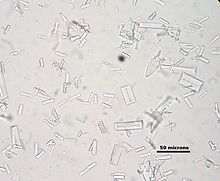Crystalluria refers to crystals found in the urine when performing a urine test. Crystalluria is considered often as a benign condition and as one of the side effects of sulfonamides and penicillins.
| Crystalluria | |
|---|---|
 | |
| Comparison of different types of urine crystals |

The main reason for the identification of urinary crystals is to detect the presence of the relatively few abnormal types that may represent a disease.
Clinical significance edit
It can be an indication of urolithiasis.
It may be relevant when there is presence of specific abnormal types of crystals (cystine, cholesterol, leucine, tyrosine, etc.)[1] and that may be a sign of metabolic or liver disorders such as cystinuria.[2]
Microcrystallization is irritating to the uroepithelium and can lead to symptoms including dysuria, frequency, urgency, and urinary incontinence, as well as hematuria, just like in urinary tract infection. [3]: 346
References edit
- ^ MrlabTest - Crystals in urine, Crystalluria. URL: https://www.mrlabtest.com/urinalysis/crystals-urine.htm. Accessed on: December 10, 2021.
- ^ Daudon M, Cohen-Solal F, Barbey F, Gagnadoux MF, Knebelmann B, Jungers P (July 2003). "Cystine crystal volume determination: a useful tool in the management of cystinuric patients". Urol. Res. 31 (3): 207–11. doi:10.1007/s00240-003-0319-0. PMID 12748836. S2CID 12341569.
- ^ Massengill, Susan F. (2008-10-01). "Hematuria". Pediatrics in Review. 29 (10): 342–348. doi:10.1542/pir.29.10.342. ISSN 0191-9601. PMID 18829770.
External links edit